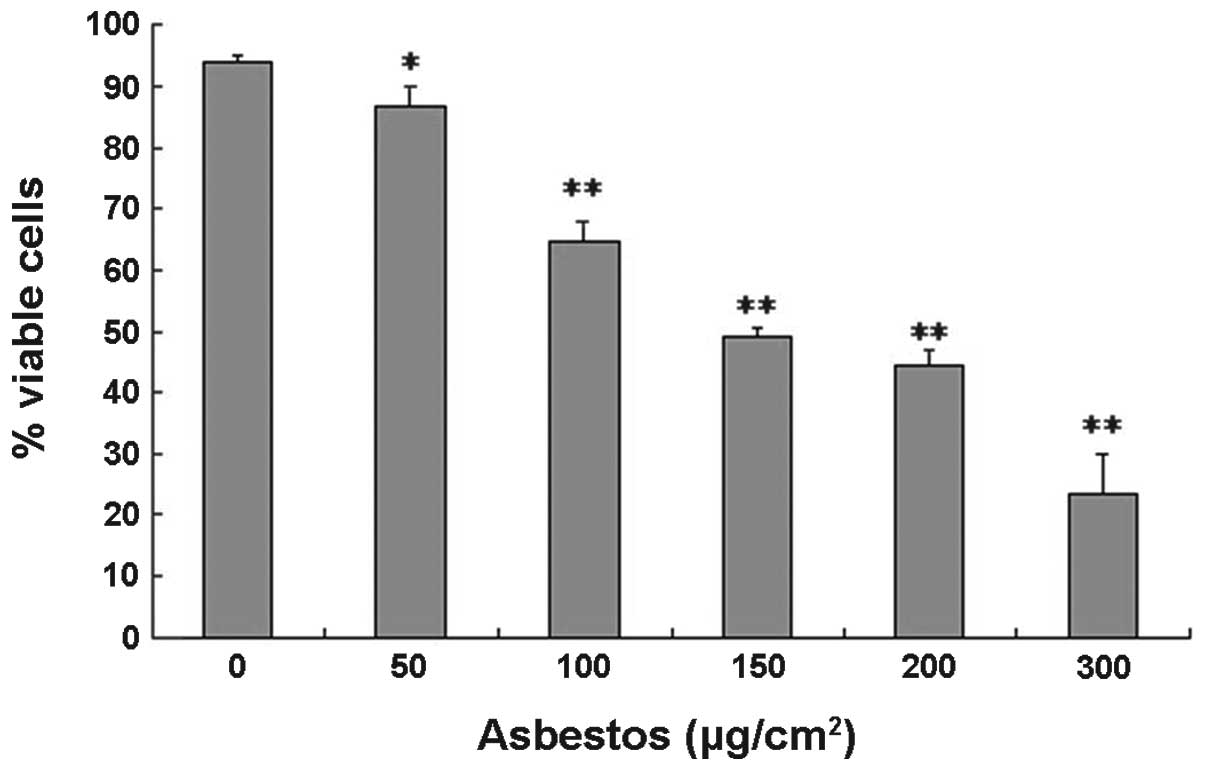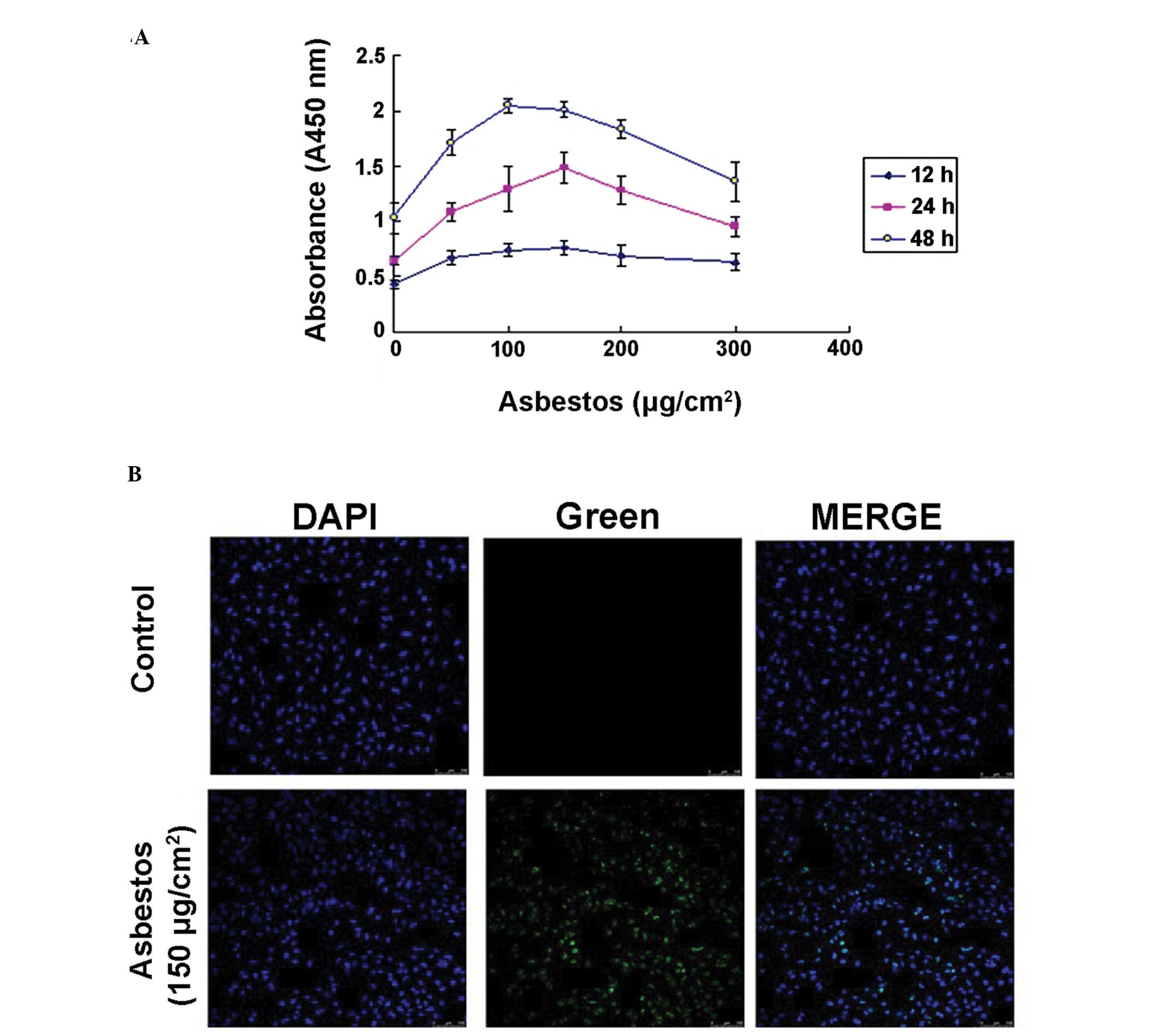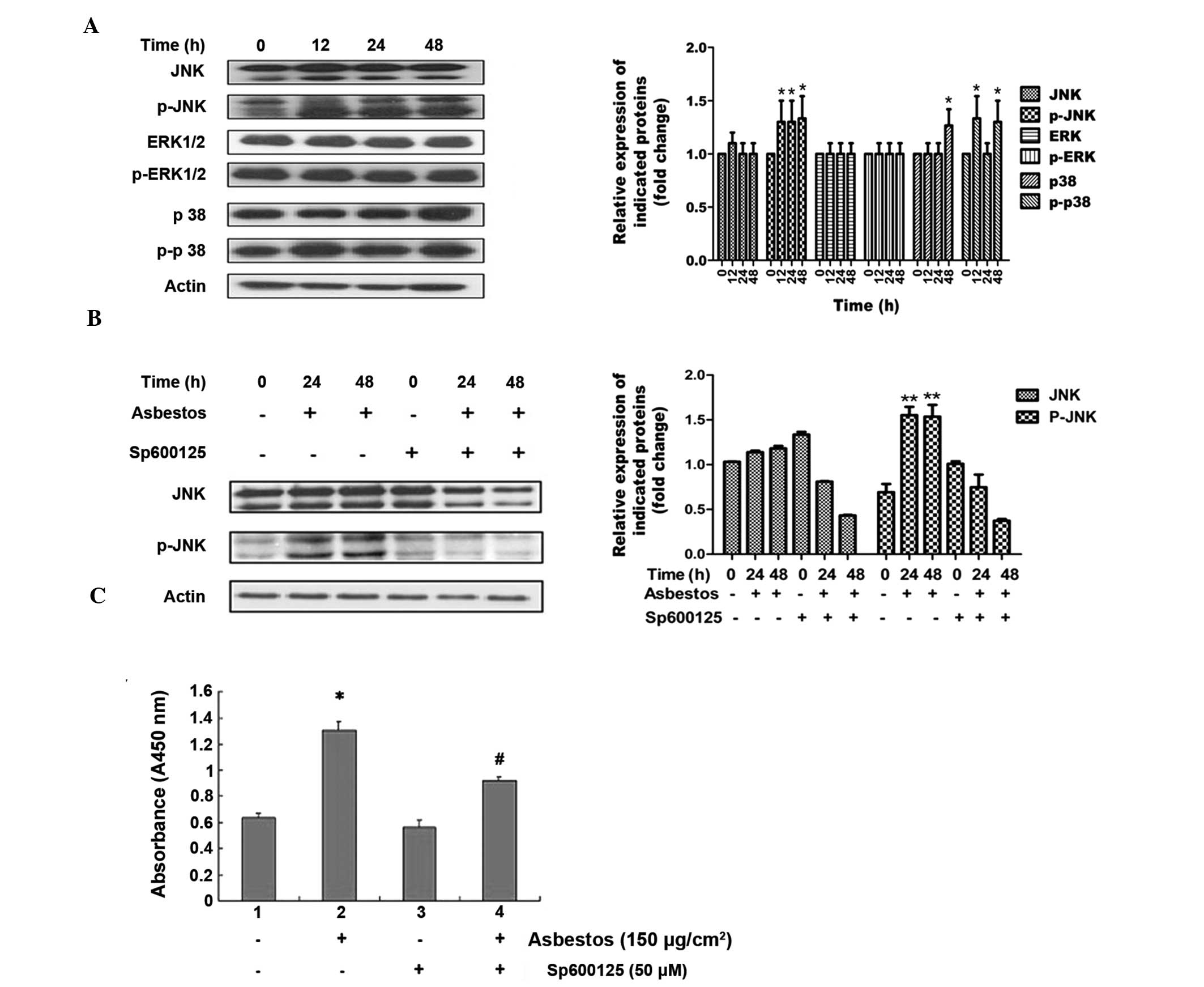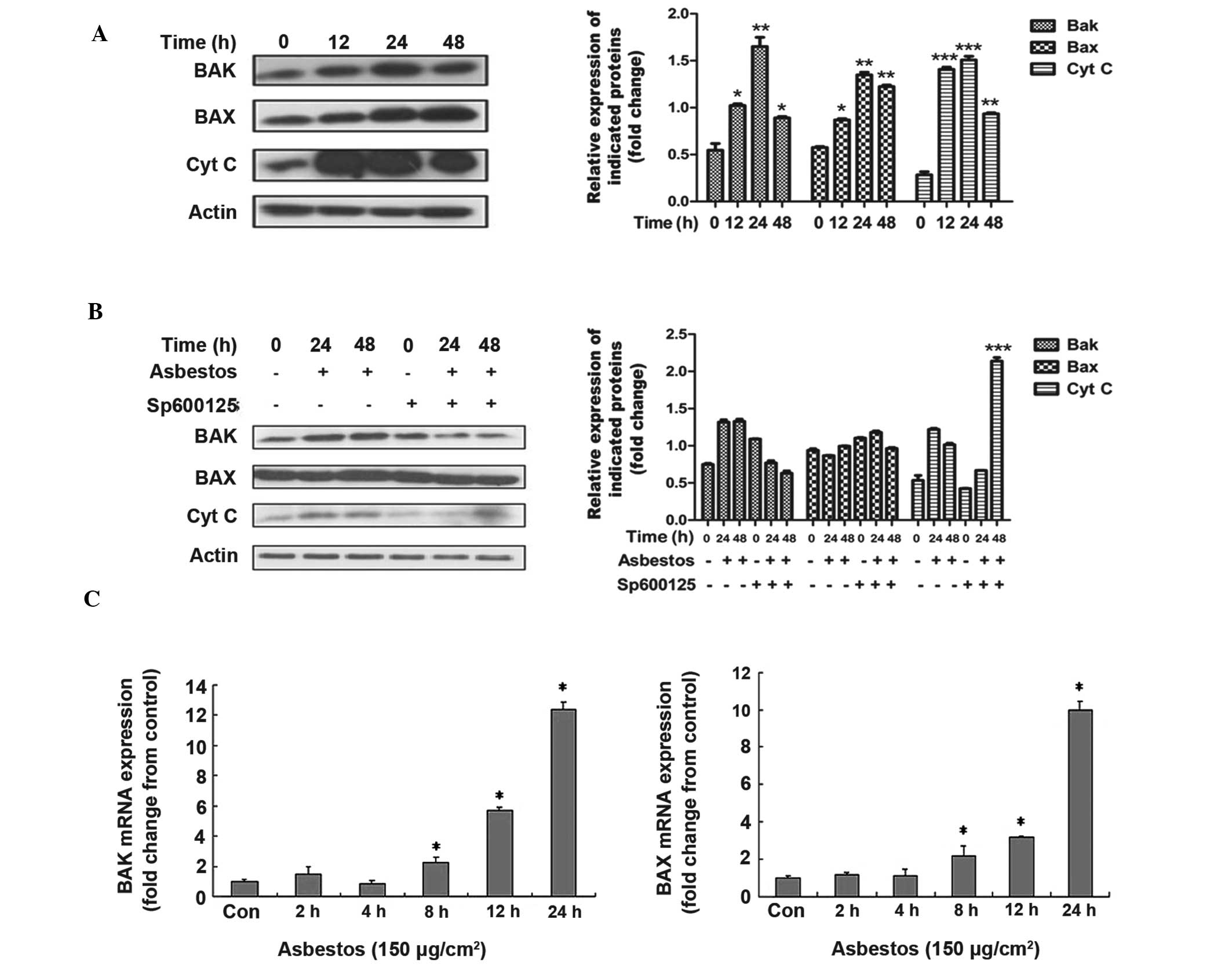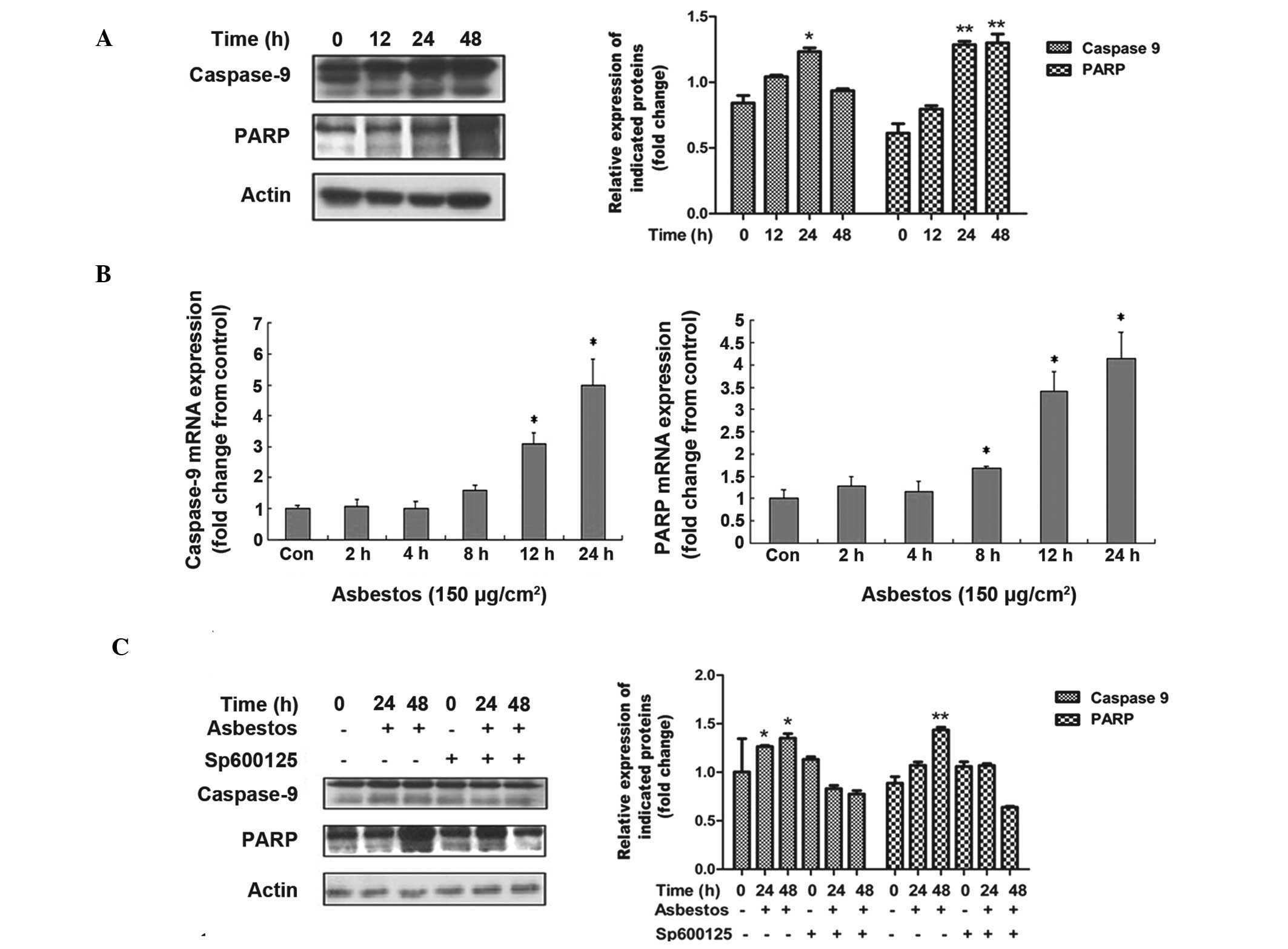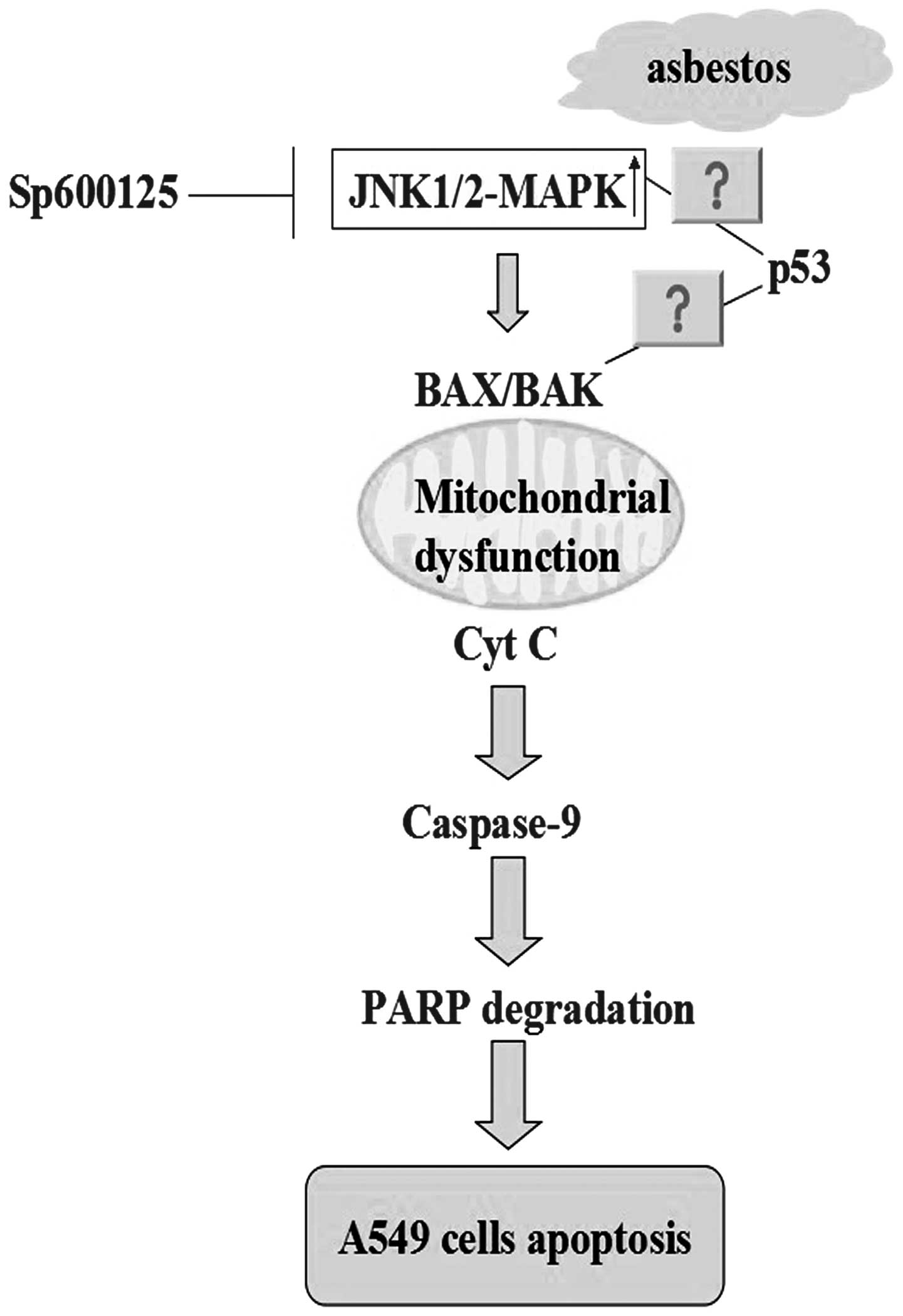|
1
|
Mossman BT, Kamp DW and Weitzman SA:
Mechanisms of carcinogenesis and clinical features of
asbestos-associated cancers. Cancer Invest. 14:466–480. 1996.
View Article : Google Scholar : PubMed/NCBI
|
|
2
|
Kamp DW: Asbestos-induced lung diseases:
an update. Transl Res. 153:143–152. 2009. View Article : Google Scholar : PubMed/NCBI
|
|
3
|
Liu G, Beri R, Mueller A and Kamp DW:
Molecular mechanisms of asbestos-induced lung epithelial cell
apoptosis. Chem Biol Interact. 188:309–318. 2010. View Article : Google Scholar : PubMed/NCBI
|
|
4
|
Liu G, Cheresh P and Kamp DW: Molecular
basis of asbestos-induced lung disease. Annu Rev Pathol. 8:161–187.
2013. View Article : Google Scholar : PubMed/NCBI
|
|
5
|
Lin Z, Liu T, Kamp DW, Wang Y, He H, Zhou
X, Li D, Yang L, Zhao B and Liu G: AKT/mTOR and c-Jun N-terminal
kinase signaling pathways are required for chrysotile
asbestos-induced autophagy. Free Radic Biol Med. 72:296–307. 2014.
View Article : Google Scholar : PubMed/NCBI
|
|
6
|
Heintz NH, Janssen-Heininger YM and
Mossman BT: Asbestos, lung cancers, and mesotheliomas: from
molecular approaches to targeting tumor survival pathways. Am J
Respir Cell Mol Biol. 42:133–139. 2010. View Article : Google Scholar : PubMed/NCBI
|
|
7
|
Huang SX, Jaurand MC, Kamp DW, Whysner J
and Hei TK: Role of mutagenicity in asbestos fiber-induced
carcinogenicity and other diseases. J Toxicol Environ Health B Crit
Rev. 14:179–245. 2011. View Article : Google Scholar : PubMed/NCBI
|
|
8
|
Buder-Hoffmann SA, Shukla A, Barrett TF,
MacPherson MB, Lounsbury KM and Mossman BT: A protein kinase
Cdelta-dependent protein kinase D pathway modulates ERK1/2 and
JNK1/2 phosphorylation and Bim-associated apoptosis by asbestos. Am
J Pathol. 174:449–459. 2009. View Article : Google Scholar : PubMed/NCBI
|
|
9
|
Aljandali A, Pollack H, Yeldandi A, Li Y,
Weitzman SA and Kamp DW: Asbestos causes apoptosis in alveolar
epithelial cells: role of iron-induced free radicals. J Lab Clin
Med. 137:330–339. 2001. View Article : Google Scholar : PubMed/NCBI
|
|
10
|
Kamp DW, Panduri V, Weitzman SA and
Chandel N: Asbestos-induced alveolar epithelial cell apoptosis:
role of mitochondrial dysfunction caused by iron-derived free
radicals. Mol Cell Biochem. 234–235:153–160. 2002. View Article : Google Scholar
|
|
11
|
Panduri V, Weitzman SA, Chandel N and Kamp
DW: The mitochondria-regulated death pathway mediates
asbestos-induced alveolar epithelial cell apoptosis. Am J Respir
Cell Mol Biol. 28:241–248. 2003. View Article : Google Scholar : PubMed/NCBI
|
|
12
|
Zanella CL, Posada J, Tritton TR and
Mossman BT: Asbestos causes stimulation of the extracellular
signal-regulated kinase 1 mitogen-activated protein kinase cascade
after phosphorylation of the epidermal growth factor receptor.
Cancer Res. 56:5334–5338. 1996.PubMed/NCBI
|
|
13
|
Baldys A and Aust AE: Role of iron in
inactivation of epidermal growth factor receptor after asbestos
treatment of human lung and pleural target cells. Am J Respir Cell
Mol Biol. 32:436–442. 2005. View Article : Google Scholar : PubMed/NCBI
|
|
14
|
Swain WA, O’Byrne KJ and Faux SP:
Activation of p38 MAP kinase by asbestos in rat mesothelial cells
is mediated by oxidative stress. Am J Physiol Lung Cell Mol
Physiol. 286:L859–L865. 2004. View Article : Google Scholar
|
|
15
|
Upadhyay D, Panduri V and Kamp DW:
Fibroblast growth factor-10 prevents asbestos-induced alveolar
epithelial cell apoptosis by a mitogen-activated protein
kinase-dependent mechanism. Am J Respir Cell Mol Biol. 32:232–238.
2005. View Article : Google Scholar
|
|
16
|
Tamminen JA, Myllärniemi M, Hyytiäinen M,
Keski-Oja J and Koli K: Asbestos exposure induces alveolar
epithelial cell plasticity through MAPK-Erk signaling. J Cell
Biochem. 113:2234–2247. 2012. View Article : Google Scholar : PubMed/NCBI
|
|
17
|
Hei TK, Piao CQ, He ZY, Vannais D and
Waldren CA: Chrysotile fiber is a strong mutagen in mammalian
cells. Cancer Res. 52:6305–6309. 1992.PubMed/NCBI
|
|
18
|
Adams JM and Cory S: The Bcl-2 protein
family: arbiters of cell survival. Science. 281:1322–1326. 1998.
View Article : Google Scholar : PubMed/NCBI
|
|
19
|
Soldani C and Scovassi AI:
Poly(ADP-ribose) polymerase-1 cleavage during apoptosis: An update.
Apoptosis. 7:321–328. 2002. View Article : Google Scholar : PubMed/NCBI
|
|
20
|
Ramazzini C: Asbestos is still with us:
repeat call for a universal ban. Am J Ind Med. 54:168–173. 2011.
View Article : Google Scholar
|
|
21
|
Li P, Nijhawan D, Budihardjo I,
Srinivasula SM, Ahmad M, Alnemri ES and Wang X: Cytochrome c and
dATPdependent formation of Apaf-1/caspase-9 complex initiates an
apoptotic protease cascade. Cell. 91:479–489. 1997. View Article : Google Scholar : PubMed/NCBI
|
|
22
|
Franco R and Panayiotidis MI:
Environmental toxicity, oxidative stress, human disease and the
“black box” of their synergism: how much have we revealed? Mutat
Res. 674:1–2. 2009. View Article : Google Scholar : PubMed/NCBI
|
|
23
|
Kroemer G, Galluzzi L and Brenner C:
Mitochondrial membrane permeabilization in cell death. Physiol Rev.
87:99–163. 2007. View Article : Google Scholar : PubMed/NCBI
|
|
24
|
Upadhyay D and Kamp DW: Asbestos-induced
pulmonary toxicity: role of DNA damage and apoptosis. Exp Biol Med
(Maywood). 228:650–659. 2003.
|
|
25
|
Shukla A, Jung M, Stern M, Fukagawa NK,
Taatjes DJ, Sawyer D, Van Houten B and Mossman BT: Asbestos induces
mitochondrial DNA damage and dysfunction linked to the development
of apoptosis. Am J Physiol Lung Cell Mol Physiol. 285:L1018–L1025.
2003. View Article : Google Scholar : PubMed/NCBI
|
|
26
|
Shukla A, Gulumian M, Hei TK, Kamp D,
Rahman Q and Mossman BT: Multiple roles of oxidants in the
pathogenesis of asbestos-induced diseases. Free Radic Biol Med.
34:1117–1129. 2003. View Article : Google Scholar : PubMed/NCBI
|
|
27
|
Shukla A, Stern M, Lounsbury KM, Flanders
T and Mossman BT: Asbestos-induced apoptosis is protein kinase C
delta-dependent. Am J Respir Cell Mol Biol. 29:198–205. 2003.
View Article : Google Scholar : PubMed/NCBI
|
|
28
|
Yuan Z, Taatjes DJ, Mossman BT and Heintz
NH: The duration of nuclear extracellular signal-regulated kinase 1
and 2 signaling during cell cycle reentry distinguishes
proliferation from apoptosis in response to asbestos. Cancer Res.
64:6530–6536. 2004. View Article : Google Scholar : PubMed/NCBI
|
|
29
|
Kido T, Morimoto Y, Asonuma E, Yatera K,
Ogami A, Oyabu T, Tanaka I and Kido M: Chrysotile asbestos causes
AEC apoptosis via the caspase activation in vitro and in vivo.
Inhal Toxicol. 20:339–347. 2008. View Article : Google Scholar : PubMed/NCBI
|
|
30
|
Soberanes S, Panduri V, Mutlu GM, Ghio A,
Bundinger GR and Kamp DW: p53 mediates particulate matter-induced
alveolar epithelial cell mitochondria-regulated apoptosis. Am J
Respir Crit Care Med. 174:1229–1238. 2006. View Article : Google Scholar : PubMed/NCBI
|
|
31
|
Frazier WJ, Xue J, Luce WA and Liu Y: MAPK
signaling drives inflammation in LPS-stimulated cardiomyocytes: the
route of crosstalk to G-protein-coupled receptors. PLoS One.
7:e500712012. View Article : Google Scholar : PubMed/NCBI
|
|
32
|
Sim YS, Kim SY, Kim EJ, Shin SJ and Koh
WJ: Impaired expression of MAPK is associated with the
downregulation of TNF-α, IL-6, and IL-10 in Mycobacterium abscessus
lung disease. Tuberc Respir Dis (Seoul). 72:275–283. 2012.
View Article : Google Scholar
|
|
33
|
Soga M, Matsuzawa A and Ichijo H:
Oxidative stress-induced diseases via the ASK1 signaling pathway.
Int J Cell Biol. 2012:4395872012. View Article : Google Scholar : PubMed/NCBI
|
|
34
|
Xia Z, Dickens M, Raingeaud J, Davis RJ
and Greenberg ME: Opposing effects of ERK and JNK-p38 MAP kinases
on apoptosis. Science. 270:1326–1331. 1995. View Article : Google Scholar : PubMed/NCBI
|
|
35
|
Aoki H, Kang PM, Hampe J, Yoshimura K,
Noma T, Matsuzaki M and Izumo S: Direct activation of mitochondrial
apoptosis machinery by c-Jun N-terminal kinase in adult cardiac
myocytes. J Biol Chem. 277:10244–10250. 2002. View Article : Google Scholar : PubMed/NCBI
|
|
36
|
Wang H, Yang YB, Shen HM, Gu J, Li T and
Li XM: ABT-737 induces Bim expression via JNK signaling pathway and
its effect on the radiation sensitivity of HeLa cells. PLoS One.
7:e524832012. View Article : Google Scholar
|
|
37
|
Xiao F, Liu B and Zhu QX: c-Jun N-terminal
kinase is required for thermotherapy-induced apoptosis in human
gastric cancer cells. World J Gastroenterol. 18:7348–7356. 2012.
View Article : Google Scholar
|















